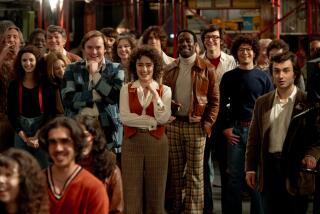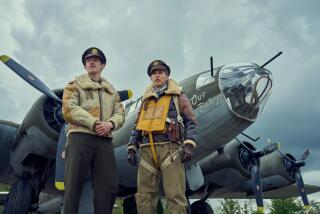‘Up in the Air’ is at the gate
- Share via
It takes an army to make a movie, hundreds of cast members and extras, miles of cable, tanker trucks of coffee . . . lights, cameras, cranes.
Now try getting that all past the Transportation Security Administration, as the filmmakers did for “Up in the Air,” the new release about a love affair with flying, in theaters nationwide on Christmas Day.
“The hardest part, by far, was crowd control,” says director Jason Reitman. “It’d be going OK, and then everyone would stop to try to get a look at George Clooney.”
Clooney plays Ryan Bingham, whose wanderlust represents Reitman’s own views. In a script written by the director, Bingham has a hyper-romanticized view of modern air travel that, to audiences, may seem more based in the past than in an era of software glitches and random flight cancellations.
But Reitman’s sense of the travel experience is well-earned.
“I started traveling a lot when I was doing commercials,” Reitman says. “There was something about unplugging with everyday life. You can read and meet people.
“There’s almost something sad about the Internet being on airplanes.”
Bingham, the travel-happy henchman, toils for an Omaha-based company that sends in downsizers to handle other companies’ layoffs. He thrives on elite club status -- Hertz Gold Cards, Admirals Clubs. His dream: to log 10 million miles in the sky.
“The slower we move, the faster we die,” he likes to say.
Airports, and travel itself, are front and center in the film, which has received strong reviews since its limited release in Los Angeles and elsewhere in early December. It was shot in a mere 50 days and used mostly mid-size airports: Omaha, Miami, St. Louis, Las Vegas and Detroit.
“The security was ridiculous,” says Eric Steelberg, director of photography. “It was much easier to shoot in the prescreening areas.”
The producers say it is the first feature to film at a TSA checkpoint and that the government required the filmmakers to use actual employees in the shots. Cast and crew had special numbered badges to get them through checkpoints.
“It is really hard to integrate with the normal operations of an airport,” Steelberg says. “They were always very nice and accommodating as long as you played by their rules.”
American Airlines, which assisted with logistics in exchange for some major branding, timed arrivals and switched gates to keep from interfering with the shoot. Still, travelers often stepped off a flight and found themselves in the middle of a movie.
“The most difficult thing was that each airport has its own rules and procedures,” says John Latenser, supervising location manager. “We had to re-teach the crew each time we changed airports.”
In the film, Reitman used newer airports in the beginning, then gradually introduced the older airports as the story turned more moody and personal. Apparent in this timeline is how airports have gone from purpose-based facilities in the ‘50s and ‘60s to retail spaces that are really just malls.
As far as favorites go, Reitman cites the wide-open spaces of the United concourse in Denver.
Steelberg, meanwhile, likes London’s Heathrow -- yes, Heathrow -- and another choice that might be a little surprising.
“LAX,” he says. “It might sound cheesy since it’s my home airport.
“It’s way too small and kind of cruddy. But from LAX, you can get anywhere in the world. . . . And when I get off the plane, it smells and feels like home.”
chris.erskine@latimes.com
More to Read
Only good movies
Get the Indie Focus newsletter, Mark Olsen's weekly guide to the world of cinema.
You may occasionally receive promotional content from the Los Angeles Times.










